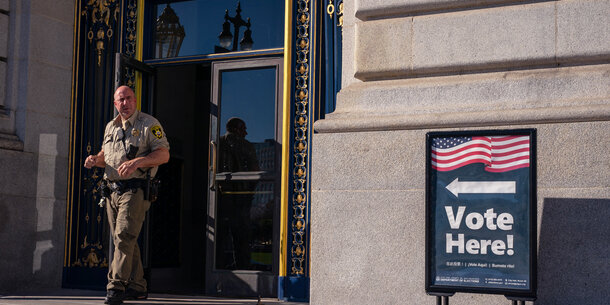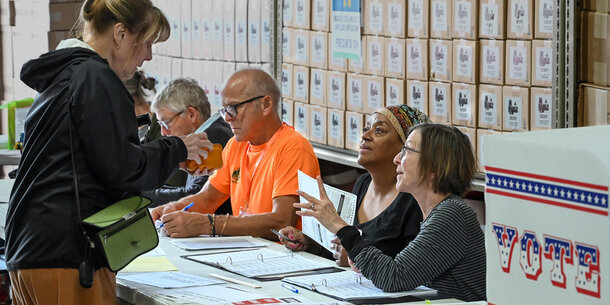The 2024 election was widely regarded as an administrative success. 1 It went off largely without a hitch, with only minor disruptions to voting. And a decisive victory by Donald Trump in the presidential campaign, paired with a prompt concession by Kamala Harris, helped avoid a long and contentious process of determining the winner, which might have eroded the perception of a well-run election.
Yet there were serious attempts at disruption, including bomb threats at polling places, cyberattacks on election systems, and destruction of ballot drop boxes. 2 That these incidents failed to have a major impact is a testament to the planning, preparation, and response of election officials and law enforcement. 3 Still, these incidents highlight the need for policymakers to double down on their commitment to the election resiliency policies and practices that made 2024 such a success.
Election resiliency is about making sure that attacks and other disruptive incidents do not impede voters from casting ballots nor prevent election workers from counting every ballot and certifying a complete and accurate count. While resiliency is top of mind for election officials, they cannot go it alone. Both the complexity of election administration and the global threat environment necessitate an all-hands-on-deck effort, with contributions from leaders across state governments. Lawmakers must set baseline security requirements and provide election officials with sufficient funding to run secure elections. Governors can direct state officials to contribute expertise, training, and resources. Law enforcement can deter attacks and hold perpetrators accountable. And all public leaders can clearly express that threats against election workers and systems will not be tolerated.
This report recommends steps that state leaders should take to strengthen the resiliency of election infrastructure. Its recommendations are informed by leading models that already exist in states but also recognize that the right approach is likely to vary by state. This report encourages a layered approach, as individual recommendations build on one another to safeguard security. And above all else, this report emphasizes the importance of planning and coordination to deter, prevent, detect, and respond to attacks on elections.
The Threat Environment
American elections face varied and often unpredictable security risks. The primary challenges so far may not be the same as those to come. Measures to counter these threats must be adaptable, strengthening resiliency against all hazards that pose risks of disruption.
Cybersecurity
Successful cyberattacks can take down or slow voter registration portals and databases, electronic pollbooks used to check voters in, election-night reporting sites, and other technology on which election officials rely to serve voters and inform the public. Such slowdowns not only inconvenience voters but erode their trust in the election process.
After the 2016 election thrust election cybersecurity into the spotlight, policymakers from across the nation and across parties ushered in new resources, guidance, and support for election officials. Aided by federal security expertise, funds, and intelligence, state and local officials enhanced their capacity to prepare for and respond to cybersecurity risks that threaten election administration. They replaced outdated systems, adopted cybersecurity best practices, and developed a strong information-sharing system. And most important, improved relationships, trust, and collaboration among officials at the state, federal, and local levels meant that election officials would no longer face cybersecurity threats on their own.
Despite these advances, foreign adversaries and domestic cyber criminals are likely to continue to probe election systems for weaknesses. Cyberattacks may also become more effective with the evolution of artificial intelligence, which can assist even unsophisticated actors in writing code or spreading malicious content. Elections require robust cyber defenses that can meet the ever-changing threat environment.
Physical Security
Physical security too has become a concern following an increase in threats against both election workers and infrastructure since the 2020 election. In a 2025 survey, more than one in three local officials said that they had experienced threats, harassment, or abuse because of their job. 4 Seasoned professionals have been driven out of election administration, contributing to unsustainable turnover.5
States have responded by passing laws to offer election workers greater legal protections. 6 In addition, the U.S. Department of Justice and the FBI investigated and prosecuted violent threats against election workers and launched public campaigns to discourage attacks. 7 Election officials also received federal physical security assessments, threat monitoring, and other resources to improve the safety of their offices and voting locations.
Despite that support, the 2024 election saw more than 200 bomb threats and multiple drop box fires, which destroyed ballots and infringed Americans’ right to vote. 8 Without thorough preparation to mitigate and respond to these risks, they may become more dangerous and destructive.
Recommendations
This report outlines a comprehensive approach to election security that emphasizes state leadership while empowering local election administrators.
The Essential Role of State Leadership
The responsibility for securing election infrastructure increasingly falls on state officials. While local election officials retain primary responsibility for running elections, they often do not have the expertise or capacity to secure election infrastructure on their own. Local election officials are dedicated public servants who excel at administering elections, but they often have limited staff and resources, which are being stretched further than ever as changing state laws place more responsibilities on them. The increasingly technical nature of election administration is widening the gap between security needs and local capabilities. And elections are facing sophisticated threats from both foreign and domestic actors. Local election officials cannot be expected to serve as frontline national security practitioners without substantial assistance.
At the same time, federal support for critical infrastructure is changing under the Trump administration as a series of reforms transfers greater responsibility for cyber and physical security to states. A recent executive order that initiates a review of all infrastructure, continuity, and preparedness policies exemplifies the administration’s approach, noting that “Federal policy must rightly recognize that preparedness is most effectively owned and managed at the State, local, and even individual levels.” 9 On election security specifically, the Department of Homeland Security and the Cybersecurity and Infrastructure Security Agency (CISA) have reduced staff who supported election security, cut funding for information-sharing networks, and paused all election security activities pending a review. 10
In a 2025 Brennan Center nationwide survey, 87 percent of local election officials said that it is important for state and local government to provide additional resources to make up for reductions in federal support for election security. 11 Moreover, local election officials overwhelmingly want the sort of support that the federal government has provided in recent years (see figure 1).
Given local limitations and shifts in federal support, continued progress on election security requires active state leadership.
The Power of Coordinated State Action
Effective election security demands a coordinated approach that brings together various government entities while respecting local authority. This collaborative model recognizes that local election officials are the experts in election administration and must lead the way in identifying needs and implementing solutions; leverages specialized expertise from state agencies; emphasizes voluntary guidance, training, and support; creates economies of scale by developing shared resources and services that benefit jurisdictions of all sizes; and establishes communication channels, relationships, and trust that facilitate rapid and effective responses when incidents arise.
A Framework for Comprehensive
Election Security
This report provides state and local officials with an actionable framework to enhance election security. It spans the following phases:
- Preparation: building relationships, shared knowledge, and communication channels across state and local governments, and creating training programs that address the specific needs of election officials.
- Deterrence: increasing legal protections for election workers and infrastructure, and communicating security and accountability measures to discourage malicious actors.
- Prevention and detection: identifying vulnerabilities, hardening systems, implementing protections, monitoring for potential attacks, and sharing threat intelligence across jurisdictions and levels of government.
- Response and recovery: developing backup systems and incident response plans, establishing clear roles and responsibilities, and ensuring minimal disruption to voting processes if incidents occur.
These phases are meant to build on one another to enhance election resiliency before, during, and after attacks, threats, and other disruptive incidents. In addition, they provide a framework for continuous improvement, as the response and recovery from real-world events can inform the types of preparation, deterrence, and prevention that can be put in place for the future. While this report advances specific recommendations (see table 1), the most effective approaches are likely to vary by state due to unique legal and policy frameworks and election administration structures.
State leaders must ensure that all election officials have the knowledge, tools, and support they need to confront all challenges that threaten to undermine U.S. elections.
Endnotes
-
1
Barbara Rodriguez, “Officials Ran a Smooth Election, Silencing the False Narrative Around Voter Fraud,” 19th News, November 6, 2024, https://19thnews.org/2024/11/smooth-election-day-silencing-false-narrative-voter-fraud/; and Katy Owens Hubler, “Every Election Administrator’s Dream: A ‘Boring’ Election,” National Conference of State Legislatures (NCSL), November 7, 2024, https://www.ncsl.org/state-legislatures-news/details/every-election-administrators-dream-a-boring-election.
-
2
Elizabeth Howard, “Preparation Kept Bomb Threats from Disrupting the 2024 Elections,” Brennan Center for Justice, March 31, 2025, https://www.brennancenter.org/our-work/analysis-opinion/preparation-kept-bomb-threats-disrupting-2024-elections; Gabe Cohen et al., “Georgia Election Official Says Battleground State Fended Off Cyberattack Likely from a Foreign Country,” CNN, October 23, 2024, https://www.cnn.com/2024/10/23/politics/georgia-election-official-cyber-attack; and Lisa Hagen, “Ballots Set on Fire in Three States as Election Day Approaches,” NPR, October 28, 2024, https://www.npr.org/2024/10/28/nx-s1–5168404/oregon-washington-arizona-ballots-drop-boxes-fires.
-
3
Jule Pattison-Gordon, “Partnerships Helped Secure Election Day Against New Threats,” Government Technology, November 14, 2024, https://www.govtech.com/public-safety/partnerships-helped-secure-election-day-against-new-threats.
-
4
Brennan Center for Justice, “Local Election Officials Survey — July 2025,” July 10, 2025, https://www.brennancenter.org/our-work/research-reports/local-election-officials-survey-july-2025. Full survey data is on file with the Brennan Center.
-
5
Joshua Ferrer et al., Election Official Turnover Rates from 2000–2024, Bipartisan Policy Center, April 9, 2024, https://bipartisanpolicy.org/report/election-official-turnover-rates-from-2000–2024/.
-
6
NCSL, “State Laws Providing Protection for Election Officials and Staff,” last updated January 13, 2025, https://www.ncsl.org/elections-and-campaigns/state-laws-providing-protection-for-election-officials-and-staff.
-
7
U.S. Department of Justice, “Voting and Elections: Election Threats,” accessed May 7, 2025, https://www.justice.gov/archives/voting/election-threats [https://perma.cc/H5QM-VAM3].
-
8
Howard, “Preparation Kept Bomb Threats from Disrupting.”
-
9
President Donald J. Trump, “Achieving Efficiency Through State and Local Preparedness,” executive order, March 19, 2025, https://www.whitehouse.gov/presidential-actions/2025/03/test/ [https://perma.cc/4XTF-KG7S].
-
10
Lawrence Norden and LaTasha Hill, “How the Federal Government Is Undermining Election Security,” Brennan Center for Justice, April 14, 2025, https://www.brennancenter.org/our-work/research-reports/how-federal-government-undermining-election-security.
-
11
Brennan Center for Justice, “Local Election Officials Survey — July 2025.”



